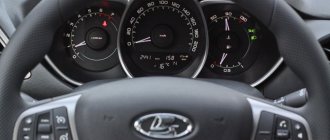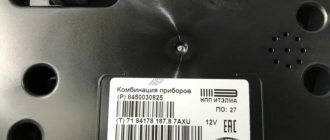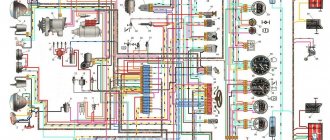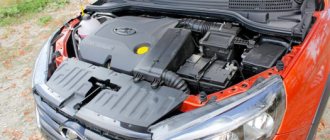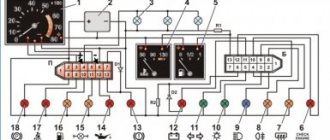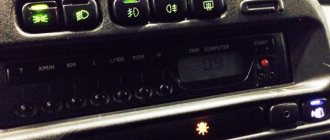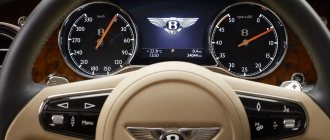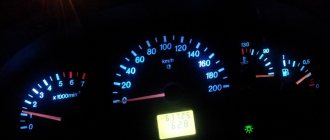The instrument panel on the Lada Vesta turned out to be functional and attractive in terms of design. It was developed virtually from scratch and is significantly different from previous AvtoVAZ production cars. In 2016, an updated version of the panel was released - the first one turned out to be somewhat unfinished, and the developers decided to fix everything along with the restyling of Vesta. Owners of cars purchased before the upgrade can use the firmware to update the dashboard.
Functions and features of the Vesta panel device
The instrument cluster on the Lada Vesta is completely different from those used on the Priora, Grant and Kalina. It is now a completely redesigned multifunctional device.
The speedometer is located in the central well - this is the main element of any “tidy” in a production car. The scale implies acceleration to 200 km/h, although in fact the stated maximum speed of Vesta with the current engine is no more than 185 km/h. Next to the speedometer there is a small on-board computer display, on which the driver can see all the necessary information about the operation of the engine and other vehicle systems.
Inside the speedometer scale there are various indicators that inform the driver about different parameters: the hazard warning lights are on and the direction indicators are on, the brake pads are critically worn, the engine is malfunctioning and the engine oil level is low. On the left is the tachometer well, the scale of which is marked from 1 to 7 (1000-7000 rpm). The engine allows you to “spin” up to 5500 rpm - this way there is no harm to the motor. After this mark there is a red zone; prolonged operation of the power unit at such high speeds is not recommended. The tachometer also contains information indicators.
On the right side there is a well in which there are two indicators. One of them informs about the engine temperature, and the second – about the fuel level in the tank. In Grant, the temperature indicator was removed to reduce the cost of the car, but in the climatic conditions of Russia and the CIS countries, it is extremely important for the driver to know the current temperature of the engine oil in order to prevent possible overheating due to various malfunctions.
The fuel tank indicator shows a scale of “full tank”, “half tank” and “empty”. You can see an arrow near the gas pump icon; it is needed to indicate to the driver which side the fuel filler neck is located (the indicator points to the right). There are also warning lights in the right well.
In general, the instrument panel has an attractive design; the scales are backlit in green and orange with white numbers. The only drawback is the poor design of the arrow indicators. The intermediate divisions of the scales are not informative, and you need to get used to them. With a quick glance while moving, it will not be easy to read the readings.
Installation and repair instructions
How to remove the tidy with your own hands:
- After disconnecting the battery, you need to unscrew the two bolts that secure the shield.
- Then grab the front of the dash and pull it towards you without any extra effort. Pull until you hear the latches click.
- Next, you need to unscrew two more screws with a screwdriver, they are located on the sides of the shield.
- Pull the device towards you and disconnect the wiring plugs located on the back side. Dismantle the shield and repair or replace it.
Features of the updated panel
In favor of AvtoVAZ, we can say that the manufacturer constantly modernizes all its cars, even new ones. Increasingly, engineers are listening to ordinary car enthusiasts (surveys on social networks, meetings with representatives, communication on forums). At the request of customers, the dashboard of the Lada Vesta has been modified. The changes include:
- the numbers have become noticeably larger, reading readings while moving has become much easier;
- the backlight is used regardless of whether the lighting is on or not, the backlight is on on all scales at any time;
- instead of white backlight, red is used;
- a voice alert now warns of an unfastened seat belt; the audio also includes a GPS connection and much more;
- the volume of sound notification and voice guidance has increased (information and warning signals);
- the time on the display is now synchronized automatically by satellites of the ERA-GLONASS navigation system;
- The warning indicators have been changed (low tire pressure and unfastened seat belts front and rear).
Export models supplied to Germany and Hungary were the first to be equipped with the updated dashboard. Since 2022, the “tidy” has become available for the domestic market. A function such as adjusting the backlight level has not yet been implemented.
Lada Vesta dashboard malfunctions
If the instrument panel is faulty, it is immediately noticeable; the following signs may indicate a problem:
- The contact of the instrument panel with the on-board electrical network is broken. The reason may be a broken wiring or damaged connectors or contacts.
- Sensor malfunction. The dashboard displays incorrect information if the crankshaft position sensor, speed sensor, or fuel level have failed.
- Mechanical damage, for example, exposure to constant vibrations or a strong impact in an accident.
- Faults related to the electronic microcircuit.
- Burnt-out indicator lights - in this case, the backlight disappears.
These malfunctions are obvious, but there are also those whose causes are not easy to understand.
Arrow indicators do not work
If the arrows on the instruments do not work, this may indicate a failure of the sensors responsible for these readings:
- The tachometer does not work. If the tachometer needle does not move, the cause of the malfunction is the device itself. If the crankshaft position sensor or electronic control unit fails, the engine cannot be started.
- The speedometer does not work. If the device is working but does not indicate speed, the cause is a faulty speed sensor. This will also be indicated by the ABS warning light.
- There is no antifreeze temperature reading. The temperature sensor is faulty and transmits incorrect readings to the control unit, which are displayed on the instrument panel.
- No fuel level readings. The unit with the fuel pump is faulty, the ECU does not receive a signal.
You can remove the instrument panel to check the functionality of the elements only after testing all sensors for malfunctions.
Burnt out warning lights
Often the reason for the lack of readings of one or another indicator is burnt-out backlight bulbs. There is a special test to check their performance. When you turn the ignition key, the ECU should start all the instruments and light up all the warning lights in test mode. At this time, you should make sure that the red lamps are working properly (they indicate major problems in the operation of the systems):
- signal indicator of the hand brake and the serviceability of the brake system;
- power steering failure indicator;
- lack of battery charge;
- low oil pressure indicator;
- indicator of security system problems.
Ignoring failure of the listed sensors leads to serious consequences, including failure of the engine and some vital systems for the car.
Indication icon designations
All this rigmarole of instrument combinations and icons is essentially needed in order to monitor the current state of the car, and even more specifically, in order to respond in time to the emergence of a threat to one’s own safety during the operation of the same Vesta SV. As for the decoding of digital symbols, then:
- The tachometer needle should not be allowed to be in the red sector of the device. Also, there is no need to choose such engine speeds that the engine does not stall and that there are no jerks. In this case, the needle should not be lower than at 800 and more than 1200 revolutions.
- Indicates that your seat belt is not fastened.
- Problems with the active safety system (or airbags).
- Warns of brake system failure.
- The power steering system may fail.
- Signals that there are problems in the engine.
- You should pay attention to the battery.
- Indicates problems with ABS.
- Speedometer needle.
- The hood is open or there are problems with its lock.
- An icon indicating that the alarm is on.
- Alarm about doors not properly closed.
- The blinking of these arrows indicates that the corresponding turn signals are turned on and are operating normally.
- Location of data on the operation of various systems using a liquid crystal display (see the following photos, as well as a table of decoding of the digital readings of the LCD display).
Removing the instrument panel
If the malfunction of the devices is definitely related to the failure of the “tidy” elements, you can begin to dismantle it. To work, you will need a screwdriver (curly and flat), as well as a hex wrench. The procedure looks like this:
- Open the hood and disconnect the terminals from the battery. This will de-energize the on-board network and prevent a short circuit in the dashboard.
- Using a screwdriver, unscrew the two screws securing the tidy.
- Pull the top part towards you until it clicks. The instrument panel assembly can then be removed.
Now you can begin to disassemble the instrument cluster. The same tools are needed for this. There are fastening screws on the left and right - unscrew them. Now, without touching the wires, you should pull the combination towards you and disconnect the wire block in the upper right part. When installing, do not confuse the pinout. Now the instrument panel has been completely removed, you can inspect it for burnt parts.
Signal indicators are checked with a multimeter.
To reinstall the panel, you need to repeat all the steps in reverse order. Removal can be done with your own hands, without the help of specialists. But in the absence of appropriate skills, it is better to entrust the diagnosis to professionals; the approximate cost of such a service will be 1000-2000 rubles. During dismantling, you can glue the dashboard so that the panel does not creak.
Photo gallery
1. Designation of tidy elements for removal
2. Self-tapping screws are marked with number 1; they must be unscrewed
3. Number 3 marks the connector with wiring
Loading...
Dashboard firmware
After the not entirely successful first “tidy” of Vesta, an updated one was released, with the defects corrected. The question arises - what should the owners of the first generation Lada Vesta do? In order for the backlight to work in the daytime without turning on the headlights, you can reflash the “tidy”. If the car is equipped with cruise control not at the factory, but by the owner, the corresponding indication on the old panel without firmware will not light up.
Without the skills and knowledge, installing software yourself can do more harm than good. The tailoring must be used strictly for the specific dashboard. It is not allowed to install updated software from a new device to an old one and vice versa.
Symbols on the liquid crystal display
| No. | What do the buttons on the panel mean? |
| 1. | Vehicle mileage meter |
| 2. | Odometer for last trip |
| 3. | Watch |
| 4. | Travel time |
| 5. | Average speed calculation |
| 6. | Transfer position |
| 7. | Mains voltage indication |
| 8. | Online fuel consumption |
| 9. | Average fuel consumption |
| 10. | Fuel consumption per trip |
| 11. | Remaining fuel reserve |
| 12. | Indication of the current gear (for AMT) |
| 13. | Outside air temperature |
| 14. | Speed Limit |
| 15. | Cruise control |
| 16. | Sound notification of the current gearbox |
Do-it-yourself firmware
You need to be aware that all actions are performed at your own peril and risk. No one can guarantee that after installing the firmware yourself, the device will work correctly. To prevent this outcome, it is recommended to update the panel either at an authorized dealer or at specialized service stations.
There is no need to confuse the panel firmware with the multimedia firmware - these are different devices.
The cost of such a service varies from 1,500 to 2,500 thousand rubles. This is much cheaper than buying a new shield to replace a damaged one yourself. For dismantling and reflashing, the warranty may be revoked if the procedure is not carried out by an authorized dealer. If you decide to update the software yourself, you will need to make a backup copy of the standard firmware, then prepare the necessary tools:
- A device for flashing Usbdm OSBDM V4.95 - can be ordered on AliExpress, the cost is approximately 600-700 rubles.
- Install drivers and software for Windows from the disk included with the programmer.
- Dismantle the instrument panel, peel off the factory seal, and remove the cover from the back.
- Open the programmer and move the checkbox to the 3.3V position - at this voltage you will not need an external power source.
- Connect to the dashboard and PC.
- On a computer or laptop, open the HCS12 Programmer program, select and click on the “Detected” item.
- Go to the “Target” item and select the folder with the location of the firmware, check the box next to the “Auto Reload” item, then click on “Detect Chip”. The programmer will determine the chip type automatically.
- Go to the “Security” tab and check the “Unsecure” box.
- In the “Advanced” tab, check the “Enable” box.
- In the “Device Operations” section on the “Target” tab, select the “Erase Selective” item - only the firmware will be replaced, the immobilizer data and mileage will be saved.
Now you can click on the “Program Flash” button - the firmware process will start. This will last a few seconds. After completion, when prompted by the program to connect the dashboard, click “No”. The flashing device can be turned off and the instrument panel replaced.
Disassembly procedure
Many people are interested in whether it is possible to remove the dashboard of a VAZ 2110 without “demolishing” the floor of the cabin?
It's probably possible, but it would be very inconvenient. Therefore, we act according to this plan:
- Let's prepare a marker and self-adhesive labels (which are usually glued to the product). They can be bought at points where all sorts of small things are sold such as napkins, bags, etc., as well as in stationery stores;
- We remove the front seats from the interior;
- We unscrew the screws on the sides, remove the tunnel (first its upper part, then the lower);
- We disassemble the steering column casing, remove it and the steering wheel. To do this, you need to unscrew 3 self-tapping screws and 4 screws. Please note that the VAZ 2110 steering wheel sits quite tightly on the splines, so you need to remove it by rocking and tugging, but being careful of a sharp blow to the face, if you suddenly overdo it and it will fly out;
- Next are the steering column switches. They also need to be removed;
- Don’t forget to mark everything and write down on a piece of paper what we are filming;
- We unscrew the glove compartment (in “understandable” language - the glove compartment) and also take it out;
- Next comes the disassembly of the mounting block and its cover. To do this, disconnect all connectors and relays;
- Now we have almost opened the instrument panel on the VAZ 2110. All that remains is to remove the strut covers, unscrew the headlight hydraulic adjustment and push it inward;
- Now the main task is to unscrew the screws securing the instrument panel to the body. To remove it completely, you need to unscrew the two studs located under the covers of the tunnels for supplying air to the side windows.
After all these manipulations, the panel hangs, and is held in place only by the steering shaft and the lower air duct.
An article discussing the process of replacing the panel overlay is located here: https://vazweb.ru/desyatka/salon/nakladka-na-panel.html
Refinement of the instrument panel
Tuning the instrument panel on the Lada Vesta is no different from upgrading it on other VAZ models, although technologically it is a completely different panel. The main idea is to improve the backlight by replacing standard SMD LEDs with alternative ones. Decorative overlays and lighting modifications without firmware are also used.
Replacing backlight LEDs
Before you begin, you should take into account that you will have to work with a soldering iron; without knowledge of soldering technology, you can lose the backlight at best. At worst, the instrument panel will fail completely. To work, you will also need to purchase LEDs with a brightness of 3 to 15 lumens, depending on the level of desired brightness. During the tuning procedure, you need to follow some recommendations:
- be careful and careful not to damage the traces of the microcircuits;
- When soldering, observe the correct polarity of the LEDs;
- Do not hold the soldering iron tip for too long - the LEDs will fail due to overheating.
To make sure the LEDs are working properly, you will need a multimeter. The tester probes are connected to the “legs” of the diodes - a working diode will indicate the integrity of the circuit (a sound signal).
If you are satisfied with the brightness level of the backlight, but would like to change the color, it is not at all necessary to solder the LEDs, you can purchase a special overlay for the instrument cluster or make it yourself - the drawings are freely available. Color film may be used. Before assembling the instrument panel, you can additionally paint the wells.
Connecting the backlight to work with DRLs during the day
This can be done using firmware or a jumper directly on the electronic board. Any tampering with the electrical system will void the vehicle's warranty. In the absence of skills and experience, such actions can lead to failure of the instrument cluster.
The main task of the procedure is to solder a jumper from the contact of the LEDs responsible for illuminating the panel to the contacts of the LEDs responsible for illuminating the display of the on-board computer (lights up when the ignition key is turned). Any suitable piece of wire can be used as a jumper. At first glance it may seem complicated, but for experienced VAZ car owners such modifications are standard practice. Rarely do such requests come to specialized centers. The replacement of LEDs is not carried out by an official dealer, nor is the installation of all kinds of overlays.
Reviews
| № | Positive |
| 1. | Vasily , 28 years old (drive2.ru), Sverdlovsk: I have one of the first Lada Vestas, an old-style dashboard. The information content is enough, I’m not going to change it with a new one. |
| 2. | Sebastian , 48 years old (prom.ua), Omsk: on the recommendation of his friends, I purchased a new instrument panel. I installed it myself, there is nothing complicated about it. The functionality of the new shield is much wider than the previous one. |
| 3. | Vitaly , 37 years old (autotoday.com), Krasnodar: I have no complaints about the panel, it works properly, correctly, I haven’t noticed any speed errors. |
| 4. | Kirill , 48 years old (rozetka.ua), Rostov-on-Don: for two years of operation of the car there were no damage to the dashboard or instruments. Functionality is 100% complete. I am pleased with the quality of manufacturing and assembly of the Lada Vesta. |
| 5. | Vasily Petrovich , 46 years old, Kursk (avtoflit.com): I’ve heard a lot about the expanded functionality of the new instrument panel. For now, a full-time one is enough for me; I’m not ready to pay 7–8 thousand for an accessory, and there’s no need for it. |
| 6. | Semyon , 44 years old, Saratov (autotoday.com): recently installed a new dashboard on a Lada Vesta. Wider functionality, button programming capabilities, adaptive backlighting. |
| 7. | Konstantin , 45 years old, Stavropol (drive2.ru): my recommendations for motorists on the new type of instrument panel on the Lada Vesta. I've been using it for more than a year, more functions, more information. |
| Negative | |
| 8. | Dmitry , 39 years old (prom.ua), Uralsk: after installing the instrument panel, the speedometer does not display the vehicle speed correctly. The specialists said that the equipment needed to be reflashed; apparently, the code was “crooked.” |
| 9. | Semenovich , 45 years old, Moscow (avtoflit.com): the new switchboard began to creak after installation, so I had to cover it with foam rubber. |
| 10. | Gennady , 37 years old, St. Petersburg (drive2.ru): I don’t see any particular need to switch to a new device, the functionality of the old one suits me quite well. |
| 11. | Stanislav , 47 years old, Pskov (autotoday.com): I’m in no hurry to install an updated device because its firmware is damp, I heard that it incorrectly displays the car’s speed. |
